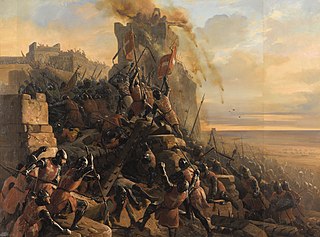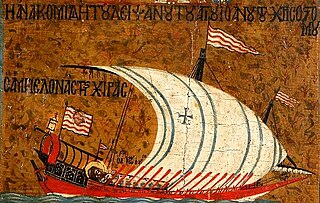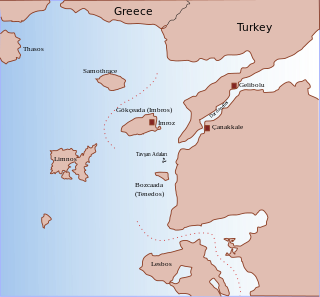Related Research Articles

The Action of 8 July 1716 was an indecisive naval battle that took place on 8 July 1716 during a Turkish attempt to capture the island of Corfu (Kerkyra), off the west coast of mainland Greece.

Aruj Barbarossa, known as Oruç Reis to the Turks, was an Ottoman corsair who became Sultan of Algiers. The elder brother of the famous Ottoman admiral Hayreddin Barbarossa, he was born on the Ottoman island of Midilli and died in battle against the Spanish at Tlemcen.

The Battle of Djerba took place in May 1560 near the island of Djerba, Tunisia. The Ottomans under Piyale Pasha's command overwhelmed a large joint Christian alliance fleet, composed chiefly of Spanish, Papal, Genoese, Maltese, and Neapolitan forces. The allies lost 27 galleys and some smaller vessels as well as the fortified island of Djerba. This victory marked perhaps the high point of Ottoman power in the Mediterranean Sea.
Kemal Reis was an Ottoman privateer and admiral. He was also the paternal uncle of the famous Ottoman admiral and cartographer Piri Reis, who accompanied him in most of his important naval expeditions.

Martino Zaccaria was the Lord of Chios from 1314 to 1329, ruler of several other Aegean islands, and baron of Veligosti–Damala and Chalandritsa in the Principality of Achaea. He distinguished himself in the fight against Turkish corsairs in the Aegean Sea, and received the title of "King and Despot of Asia Minor" from the titular Latin Emperor, Philip II. He was deposed from his rule of Chios by a Byzantine expedition in 1329, and imprisoned in Constantinople until 1337. Martino then returned to Italy, where he was named the Genoese ambassador to the Holy See. In 1343 he was named commander of the Papal squadron in the Smyrniote crusade against Umur Bey, ruler of the Emirate of Aydin, and participated in the storming of Smyrna in October 1344. He was killed, along with several other of the crusade's leaders, in a Turkish attack on 17 January 1345.

In 1480 the small Knights Hospitaller garrison of Rhodes withstood an attack of the Ottoman Empire.

The history of Rhodes under the Order of Saint John lasted from 1310 until 1522. The island of Rhodes was a sovereign territorial entity of the Knights Hospitaller who settled on the island from Palestine and from Cyprus, where they did not exercise temporal power. The first Grand Master was the Frenchman Foulques de Villaret (1305–1319).
Juneyd or Junayd Bey was the last ruler (bey) of the Aydınid principality in what is now central western Turkey. His exact relationship with the Aydınid dynasty is unclear. His father was a long-time and popular governor of Smyrna under the Ottoman sultan Bayezid I. This allowed Junayd to consistently rely on the loyalty of the area's populace.
The Genoese occupation of Rhodes refers to the period between 1248 and late 1249/early 1250 during which the city of Rhodes and parts of the namesake island were under Genoese control. The Genoese took possession of the city and island, a dependency of the Empire of Nicaea, in a surprise attack in 1248, and held it, with aid from the Principality of Achaea, against Nicaean attacks until 1250.
The Battle of Chios was a naval battle fought off the shore of the eastern Aegean island of Chios between a Latin Christian—mainly Hospitaller—fleet and a Turkish fleet from the Aydinid emirate. The Christian fleet was victorious, but for the Aydinids, who had been engaging in piracy since the collapse of Byzantine power, it was only a temporary setback in their rise to prominence.
Albert of Schwarzburg, in contemporary sources also Albertus Alamanus or Albertus de Nigro Castro, was a member of the Saxon–Thuringian House of Schwarzburg who became a member of the Knights Hospitaller, rising to be marshal and grand preceptor of the Order, and fighting with success against the Turks.
Andrea Morisco was a Genoese pirate active in the Aegean Sea in the late 13th century, who in 1304 entered the service of the Byzantine Empire. As an admiral and corsair, he was active under Byzantine colours until 1308, when he was captured and executed in Cyprus.

The Hospitaller conquest of Rhodes took place in 1306–1310. The Knights Hospitaller, led by Grand Master Foulques de Villaret, landed on the island in summer 1306 and quickly conquered most of it except for the city of Rhodes, which remained in Byzantine hands. Emperor Andronikos II Palaiologos sent reinforcements, which allowed the city to repel the initial Hospitaller attacks, and persevere until it was captured on 15 August 1310. The Hospitallers transferred their base to the island, which became the centre of their activities until it was conquered by the Ottoman Empire in 1522.
The Battle of Pallene occurred in 1344 between the fleets of a Latin Christian league and Turkish raiders, at the Pallene Peninsula in northern Greece.
The Battle of Megara occurred in 1359 between an alliance of the Christian states of southern Greece, and of a Turkish raiding fleet. The battle was a victory for the allies.

The Battle of Adramyttion occurred in autumn 1334 between the fleets of a Christian naval league, headed by the Republic of Venice and the Knights Hospitaller, and of the Turkish beylik of Karasi. The battle was a Christian victory.

The Battle of Gallipoli occurred on 29 May 1416 between the fleets of the Republic of Venice and the Ottoman Empire off the port city of Gallipoli, the main Ottoman naval base. The battle was the main episode of a brief conflict between the two powers, resulting from Ottoman attacks against possessions and shipping of the Venetians and their allies in the Aegean Sea in 1414–1415. The Venetian fleet, under Pietro Loredan, was charged with transporting a Venetian embassy to the Ottoman sultan, but was authorized to attack if the Ottomans refused to negotiate. The subsequent events are known chiefly from a detailed letter written by Loredan after the battle.

The siege of Rhodes was a military engagement involving the Knights Hospitaller and Mamluk Sultanate. The Mamluk fleet landed on the island of Rhodes on 10 August 1444, besieging its citadel. Clashes took place on the western walls of the city and at the Mandraki harbor. On 18 September 1444, the Mamluks departed from the island and lifted the siege.
The Battle of Imbros occurred in spring 1347 between the fleets of a Christian naval league formed as part of the Smyrniote crusades, and of a Turkish raiding fleet, possibly from the beyliks of Aydin and Sarukhan. The Turks abandoned their ships and landed on the island of Imbros, where most were captured.
In 1320, the Turks of Menteshe launched an unsuccessful attempt to conquer the island of Rhodes from the Knights Hospitaller.
References
- ↑ Luttrell 1975, pp. 283–285.
- ↑ Luttrell 1975, pp. 286–287.
- ↑ Carr 2013, pp. 167–168.
- 1 2 3 Luttrell 1975, p. 287.
- 1 2 Carr 2013, p. 168.